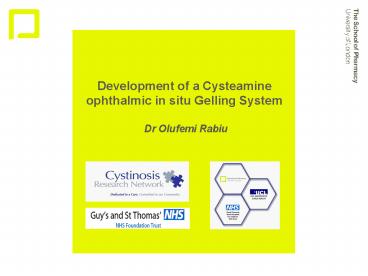Development of a Cysteamine ophthalmic in situ Gelling System - PowerPoint PPT Presentation
1 / 12
Title:
Development of a Cysteamine ophthalmic in situ Gelling System
Description:
Rare autosomal recessive condition. Characterised by excessive cystine accumulation within lysosomes of various cells in the body. ... – PowerPoint PPT presentation
Number of Views:365
Avg rating:3.0/5.0
Title: Development of a Cysteamine ophthalmic in situ Gelling System
1
Development of a Cysteamine ophthalmic in situ
Gelling System
Dr Olufemi Rabiu
2
Cystinosis ophthalmic symptoms
- Rare autosomal recessive condition.
- Characterised by excessive cystine accumulation
within lysosomes of various cells in the body. - Symptoms renal Fanconi syndrome, growth
retardation, corneal erosions, blurred vision and
photophobia.
Untreated
Treated
(Gahl, Thoene et al. 2002)
3
Cysteamine topical treatment
- Oral therapy (cysteamine hydrochloride) has no
effect on ocular symptoms. - Topical cysteamine drops have been developed and
in use since 1986. - Current UK formulation (0.55) is produced by
the pharmacy-manufacturing unit at Guys and St.
Thomas NHS Foundation Hospital. - Recommended frequency of administration is hourly
during the initial treatment phase followed by
four to six times a day - POOR PATIENT COMPLIANCE
4
Aim of the project
Increased residence time in the eye
- Develop a formulation to reduce the frequency of
administration using the concept of in situ
gelling system.
Increased Bioavailability
Reduced dosing frequency
IMPROVED COMPLIANCE
5
In situ gelling systems
Liquid Drops
Gel
- Ions
- Gellan gum
- Alginate
- pH
- Carbomers
- Chitosan
Combinations of polymers
- Temperature
- Poloxamer
- HPMC, MC
6
In situ gelling systems
- Various concentration of combinations of
temperature sensitive polymers with moderate
mucoadhesive capacity were further tested - HPMC
- Poloxamer 407/Poloxamer 188
- Poloxamer 407/Poloxamer 188/ HPMC
Mechanism of temperature induced gelation
Cellulose derivatives
Poloxamer
7
Evaluation of the formulations
- Rheology
- ? in vitro behaviour of the gel
- Viscosity
- RT (25C) / 34C
- Undiluted / Diluted with simulated tear fluid
(STF) or water (257) - Shear rates
- Low 10s¹ (squeezing out of bottle)
- Medium 100s¹ (normal blinking)
- High 200s¹ (fast blinking)
- Oscillation
- mimic behaviour once in the eye at 34C diluted
with STF, with blinking
8
Evaluation of the formulations
- Dialysis Bag Method
- ? In vitro cysteamine drug release
- Dialysis membrane bag
- (cut off 12,000-14,000 Da).
- Immersed in STF at 34C under gentle
- magnetic stirring
- Sampling done at over 8 hours
- Drug content assayed by iodometric titration
- (validated method)
9
Characterisation of ophthalmic preparations
- pH physiological
- Good dropability 42 ul
- Non Newtonian viscoelastic flow type not
deformed after application of stress (blinking),
good tolerance because of blinking adaptation,
not easily drained - Good comparison with commercially available (in
situ) gels (eg for dry eyes and tear deficiency
etc)
10
Slower cysteamine release gels
N3
11
Conclusion
- Ternary combination of 2 Poloxamers and HPMC in
higher concentrations were found to be suitable
to prolong the release of cysteamine while
maintaining good rheological profiles. - Future Lab Studies
- Further In Vitro drug release studies
- on Franz Diffusion Cells
- 2. Mucoadhesion assessment
- 3. In vivo evaluation of permeation and kinetic
release of cysteamine in cornea of Rabbits - And then Clinical trial
12
Any question?
- Acknowledgments to
- CRN for the funding
- B Lawal MPharm, S Lalji MPharm, U Lingam MSc, C
Tuleu - The School of Pharmacy, University of London, UK
- R Sekhri, W Vant Hoff, K Nischal
- Great Ormond Street Hospital Trust for Children
THANK YOU FOR YOUR ATTENTION!































